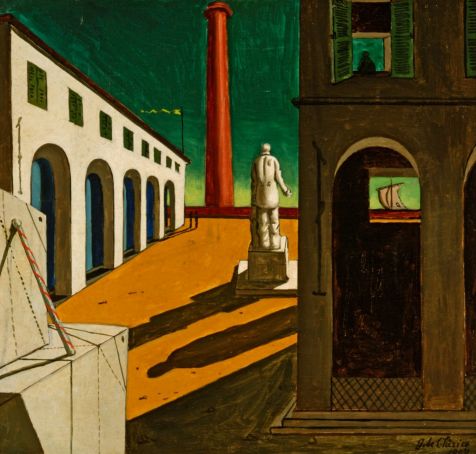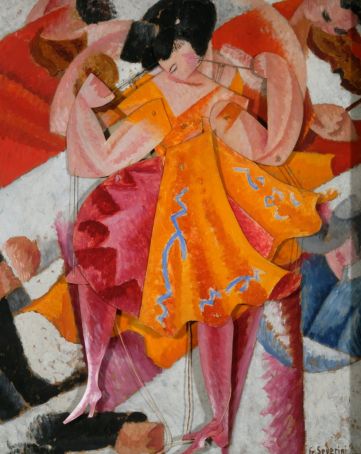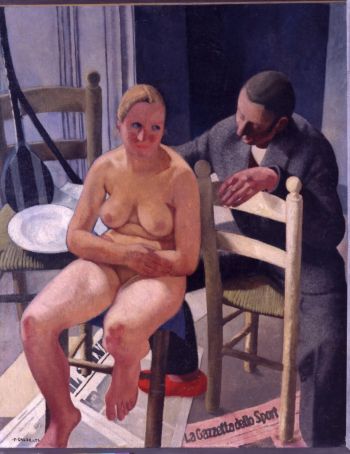Affinità Elettive: Da de Chirico a Burri at the Galleria d'Arte Moderna di Roma Capitale.
Andy Devane
17 Dec-13 March. This enlightening exhibition documents key developments in early to mid 20th-century Italian art, with a particular focus on the period between the two world wars, and comprises 80 works, divided evenly between the collections of the Galleria d’Arte Moderna di Roma Capitale and the Fondazione Magnani Rocca in Parma.
Luigi Magnani (1906-1984) was a deeply-cultured individual whose art collection has been on public display at his former home, Villa Mamiano, in the Po valley south of Parma, since 1990. In addition to being an avid patron of the arts, Magnani was a respected music and art critic, and surrounded himself with the cream of the Italian post-war intelligentsia.
Magnani didn't favour one artist or movement over another and his collection in northern Italy includes works by Lippi, Dürer, Titian, Rubens, Monet and Renoir, as well as 20th-century Italian greats such as Guttuso and Morandi. Magnani assembled his collection purely for personal reasons, based on integrity and a desire for a greater understanding of art. Indeed he was uncomfortable with the term “collector”, once stating: “I am not a friend of antique dealers, I don't attend auctions, I don't visit exhibitions.”
One of the jewels of his Italian collection is Giorgio de Chirico's L’enigma della partenza (1914), which acts as the focal point of the exhibition in Rome. Smaller than might be expected, the work is laden with the metaphysical values associated with de Chirico's dreamlike style: mystery, hidden meanings, sharply-contrasting light and shadow. Perhaps the British art expert Roderick Conway Morris put it best, stating that de Chirico painted “that which cannot be seen."

Silhouetted figures stand in a silent ochre courtyard, dominated by the rear of a statue and a towering chimney; a ship visible against the dark-green backdrop. The work is described by French writer and Surrealist André Breton in the Anthologie de l'humour noir (1940) as the “origin of modern mythology”, thanks to de Chirico's creation of a language that is "highly symbolic, concrete and universally intelligible."
The exhibition includes two works by de Chirico's brother, the writer, painter, playwright and composer Alberto Savinio, of which the glazed ceramic Senza titolo (Foresta tropicale) stands out. Created in 1945-46, the piece features an internal image of a tropical forest but is dominated by its porcelain “frame” of sea shells, ferns and pearls.
There are no less than 10 still lifes by Magnani's friend Giorgio Morandi, painted from 1927 until 1963, as well as a self portrait of the 35-year old artist, dated 1925. There are also numerous etchings by the Bolognese painter in a room dedicated to prints and the graphic arts.
Another highlight from the Magnani collection is Sacco (1954) by the pioneering painter and sculptor Alberto Burri, one of Italy's most important post-war artists. The work is part of Burri's Sacchi series, made from stitched and patched remnants of torn hession, often combined with fragments of discarded clothing. Burri, who died in 1995, achieved a new personal record in 2014 when the fine arts auction house Christies sold his Combustione Plastica for €5.6 million.
The show at Rome's municipal modern art gallery includes several works by Filippo De Pisis, the extravagant Ferrara artist who cavorted about town with his pet parrot Coco and was known for his airy, turpentine-soaked canvases and watercolours of cityscapes and still lifes.
Susanna by Felice Casorati (1883-1963) features the principal themes of the Turin artist: the portrait, figure composition, and intriguing use of perspective. Painted, beautifully, in 1929, the work features a nude Susanna sitting on a wicker chair while a red-clogged man stares lovingly at her bare back, a copy of the pink Gazzetta dello Sport at their feet.
Natura morta (1937) by Emanuele Cavalli, is a pastel-coloured piece with a perched finch, pomegranate and cheese grater while a later Natura morta (1939) by the same artist is resplendent in its complementary orange and blue. Cavalli belonged to Rome's Scuola Romana art movement in the 1930s, established on Via Cavour by Mario Mafai whose Natura morta con colonna is displayed on the third floor of the gallery.
The exhibition includes work by other artists associated with the Scuola Romana: the warm-toned Natura morta (1937) by Afro (Basaldella), rich with autumnal yellows, ochres and browns, and a lute player in background; the floral Scherzo (1916) by Cipriano Oppo who was also known for his set design work at Rome's opera house; and three works by the Roman painter and poet Toti Scialoja who died in 1998.
Nudo coricato by Carlo Mattioli (1961) features a reclining nude against a pitch-dark brown background, like a field furrowed at night, while Natura morta con pianoforte (1947) demonstrates the cubist influences in the work of Sicilian painter Renato Guttuso.
Gino Severini makes a splash with several paintings, of which Danseuse articulée (1915) radiates joy and reflects the central role of the dancer in the artist's work at the time. The fun-filled painting was designed to be operated, puppet-like, by strings, and is in stark contrast to the devastating sadness that Severini conveys in L'Angelo rapitore (1933-1935). This large painting was inspired by the death of his six-year-old son Jacques and features an angel carrying a child heaven-ward, away from his tomb cluttered with the symbols of a lost young life: toys, pellet gun, gramaphone, a yellow parrot teddy peeping out of a straw basket.

Classic figurative sculpture is represented in the gilded bronze S. Giorgio (1972) and bronze Bambina sulla sedia (1955) by Giacomo Manzù; the lacquered plaster figure Languore (1939) by Tommaso Bertolino; and the terracotta Frammento (1929) by Marino Marini.
The show also includes pieces from the collections of Rome's MACRO and Casa Museo Alberto Moravia. The art on display is enriched by music, reflecting that other great passion of the dapper Magnani, who watches over visitors thanks to a 1936 portrait by Hungarian artist László Vinkler.
General Info
View on Map
Review of the month: Affinità Elettive: Da de Chirico a Burri
Galleria d’Arte Moderna di Roma Capitale, Via Francesco Crispi 24, tel. 060608.


















